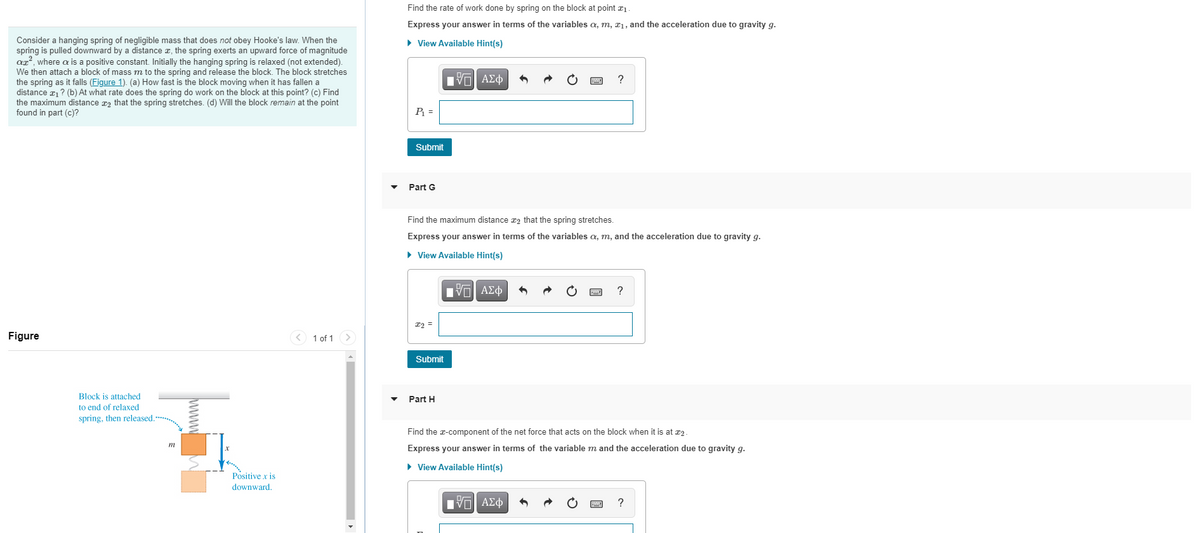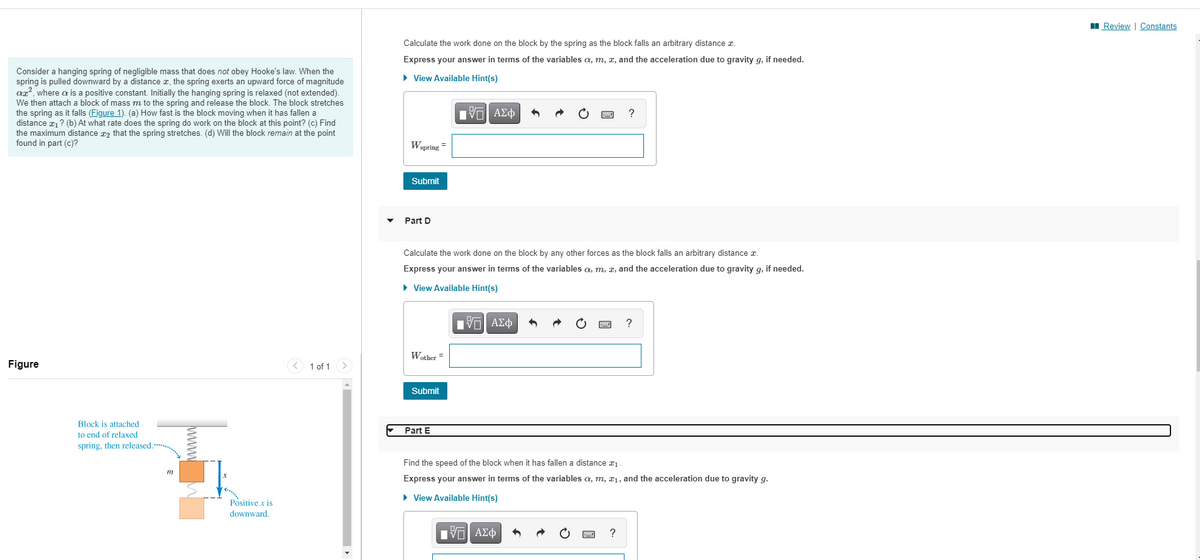Find the rate of work done by spring on the block at point z. Express your answer in terms of the variables a, m, z1, and the acceleration due to gravity g. g of negligible mass that does not obey Hooke's law. When the d by a distance z, the spring exerts an upward force of magnitude ve constant. Initially the hanging spring is relaxed (not extended). f mass m to the spring and release the block. The block stretches re 1). (a) How fast is the block moving when it has fallen a rate does the spring do work on the block at this point? (c) Find 2 that the spring stretches. (d) Will the block remain at the point > View Available Hint(s) VO AE Submit Part G Find the maximum distance zz that the spring stretches. Express your answer in terms of the variables a, m, and the acceleration due to gravity g. • View Available Hint(s) < 1 of 1> Submit attached Part H f relaxed then released. Find the z-component of the net force that acts on the block when it is at z2. Express your answer in terms of the variable m and the acceleration due to gravity g. > View Available Hint(s) Positive x is downward. ?
Find the rate of work done by spring on the block at point z. Express your answer in terms of the variables a, m, z1, and the acceleration due to gravity g. g of negligible mass that does not obey Hooke's law. When the d by a distance z, the spring exerts an upward force of magnitude ve constant. Initially the hanging spring is relaxed (not extended). f mass m to the spring and release the block. The block stretches re 1). (a) How fast is the block moving when it has fallen a rate does the spring do work on the block at this point? (c) Find 2 that the spring stretches. (d) Will the block remain at the point > View Available Hint(s) VO AE Submit Part G Find the maximum distance zz that the spring stretches. Express your answer in terms of the variables a, m, and the acceleration due to gravity g. • View Available Hint(s) < 1 of 1> Submit attached Part H f relaxed then released. Find the z-component of the net force that acts on the block when it is at z2. Express your answer in terms of the variable m and the acceleration due to gravity g. > View Available Hint(s) Positive x is downward. ?
Elements Of Electromagnetics
7th Edition
ISBN:9780190698614
Author:Sadiku, Matthew N. O.
Publisher:Sadiku, Matthew N. O.
ChapterMA: Math Assessment
Section: Chapter Questions
Problem 1.1MA
Related questions
Question

Transcribed Image Text:Find the rate of work done by spring on the block at point x1
Express your answer in terms of the variables a, m, x1, and the acceleration due to gravity g.
Consider a hanging spring of negligible mass that does not obey Hooke's law. When the
spring is pulled downward by a distance a, the spring exerts an upward force of magnitude
ar, where a is a positive constant. Initially the hanging spring is relaxed (not extended).
We then attach a block of mass m to the spring and release the block. The block stretches
the spring as it falls (Figure 1). (a) How fast is the block moving when it has fallen
distance a ? (b) At what rate does the spring do work on the block at this point? (c) Find
the maximum distance rz that the spring stretches. (d) Will the block remain at the point
found in part (c)?
• View Available Hint(s)
R =
Submit
Part G
Find the maximum distance x2 that the spring stretches.
Express your answer in terms of the variables a, m, and the acceleration due to gravity g.
• View Available Hint(s)
Vo AEO
22 =
Figure
< 1 of 1 >
Submit
Block is attached
Part H
to end of relaxed
spring, then released.
Find the x-component of the net force that acts on the block when it is at 2
m
Express your answer in terms of the variable m and the acceleration due to gravity g.
• View Available Hint(s)
Positive x is
downward.
?
wwww

Transcribed Image Text:I Review | Constants
Calculate the work done on the block by the spring as the block falls an arbitrary distance z.
Express your answer in terms of the variables a, m, x, and the acceleration due to gravity g, if needed.
Consider a hanging spring of negligible mass that does not obey Hooke's law. When the
spring is pulled downward by a distance r, the spring exerts an upward force of magnitude
ar, where a is a positive constant. Initially the hanging spring is relaxed (not extended).
We then attach a block of mass m to the spring and release the block. The block stretches
the spring as it falls (Figure 1). (a) How fast is the block moving when it has fallen a
distance z, ? (b) At what rate does the spring do work on the block at this point? (c) Find
• View Available Hint(s)
the maximum distance rz that the spring stretches. (d) Will the block remain at the point
found in part (c)?
W.
Vspring =
Submit
Part D
Calculate the work done on the block by any other forces as the block falls an arbitrary distance x.
Express your answer in terms of the variables a, m, x, and the acceleration due to gravity g, if needed.
• View Available Hint(s)
ΑΣφ
Wother =
Figure
<) 1 of 1 >
Submit
Block is attached
Part E
to end of relaxed
spring, then released.
Find the speed of the block when it has fallen a distance r1.
m
Express your answer in terms of the variables a, m, x1, and the acceleration due to gravity g.
• View Available Hint(s)
Positive x is
downward.
ΠV ΑΣφ
Expert Solution
This question has been solved!
Explore an expertly crafted, step-by-step solution for a thorough understanding of key concepts.
This is a popular solution!
Trending now
This is a popular solution!
Step by step
Solved in 2 steps with 2 images

Knowledge Booster
Learn more about
Need a deep-dive on the concept behind this application? Look no further. Learn more about this topic, mechanical-engineering and related others by exploring similar questions and additional content below.Recommended textbooks for you

Elements Of Electromagnetics
Mechanical Engineering
ISBN:
9780190698614
Author:
Sadiku, Matthew N. O.
Publisher:
Oxford University Press

Mechanics of Materials (10th Edition)
Mechanical Engineering
ISBN:
9780134319650
Author:
Russell C. Hibbeler
Publisher:
PEARSON

Thermodynamics: An Engineering Approach
Mechanical Engineering
ISBN:
9781259822674
Author:
Yunus A. Cengel Dr., Michael A. Boles
Publisher:
McGraw-Hill Education

Elements Of Electromagnetics
Mechanical Engineering
ISBN:
9780190698614
Author:
Sadiku, Matthew N. O.
Publisher:
Oxford University Press

Mechanics of Materials (10th Edition)
Mechanical Engineering
ISBN:
9780134319650
Author:
Russell C. Hibbeler
Publisher:
PEARSON

Thermodynamics: An Engineering Approach
Mechanical Engineering
ISBN:
9781259822674
Author:
Yunus A. Cengel Dr., Michael A. Boles
Publisher:
McGraw-Hill Education

Control Systems Engineering
Mechanical Engineering
ISBN:
9781118170519
Author:
Norman S. Nise
Publisher:
WILEY

Mechanics of Materials (MindTap Course List)
Mechanical Engineering
ISBN:
9781337093347
Author:
Barry J. Goodno, James M. Gere
Publisher:
Cengage Learning

Engineering Mechanics: Statics
Mechanical Engineering
ISBN:
9781118807330
Author:
James L. Meriam, L. G. Kraige, J. N. Bolton
Publisher:
WILEY